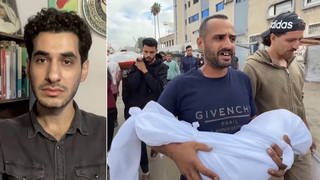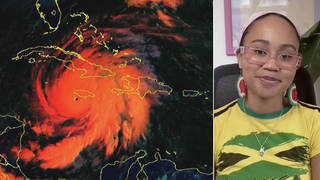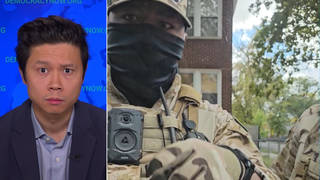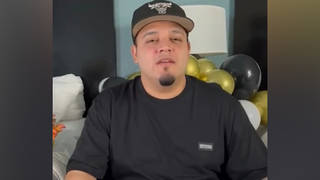
Guests
- Maximillian Alvarezeditor-in-chief of The Real News Network, based in Baltimore, Maryland.
Links
Six people are missing and presumed dead after a 984-foot cargo ship hit the Francis Scott Key Bridge in Baltimore, causing the bridge’s collapse early Tuesday morning. All six have been identified as immigrant construction workers originally hailing from Mexico, Guatemala, El Salvador and Honduras. Maryland Governor Wes Moore said the crew on the ship was able to issue an emergency mayday call before colliding with the bridge, which allowed authorities to stop incoming traffic and prevent more casualties. However, reports say the workers already on the bridge were not given similar warnings. “The question we should be asking about is why the folks on that bridge … had no direct line to emergency dispatch when they are clearly working in a potentially hazardous environment,” says journalist Maximillian Alvarez, the editor-in-chief of the Baltimore-based organization The Real News Network, who has been closely following the story and how it has affected immigrant and working-class communities. “What does this story actually show us? That immigrants are filling our potholes at night so that we can have a smooth drive to work in the morning,” Alvarez says. “I hope people can see this and see the humanity in us.”
Transcript
AMY GOODMAN: This is Democracy Now!, democracynow.org. I’m Amy Goodman, with Juan González.
Authorities in Maryland fear six missing construction workers died on Tuesday when the Francis Scott Key Bridge collapsed after a massive cargo ship crashed into a support column. Maryland’s governor said the crew on the ship was able to issue an emergency mayday call before colliding with the bridge, which allowed authorities to stop incoming traffic. This is audio from Broadcastify.com archive of Maryland Transportation Authority first responder radio traffic just before the bridge collapsed.
OFFICER 1: Yeah, if we can stop traffic, just make sure no one’s on the bridge right now. I’m not sure where [inaudible]. There’s a crew up there. You might want to notify whoever the foreman is, see if we can get them off the bridge temporarily.
OFFICER 2: Ten-four. Once the other unit gets here, I’ll ride up on the bridge. I have all interlude traffic stopped at this time. Once you get here, I’ll go grab the workers on the Key Bridge and then stop the outer loop.
OFFICER 3: C-13 dispatch. The whole bridge just fell down. Star — star, whoever, to everybody, the whole bridge just collapsed.
AMY GOODMAN: Authorities are still investigating the cause of the crash but say the ship leaving Baltimore Harbor lost propulsion and control of the vessel around 1:30 a.m. Tuesday.
The crew of men who were filling potholes on the bridge were from Mexico, Guatemala, El Salvador and Honduras, had been in this country for many years. They include a Salvadoran father of three named Miguel Luna, a Honduran father of two named Maynor Yassir Suazo Sandoval, two Guatemalan men and at least one Mexican national.
In a minute, we’ll speak with Maximillian Alvarez, editor-in-chief of the Baltimore-based news outlet The Real News, who’s been reporting on the bridge collapse. On Wednesday, he interviewed Jesus Campos, who’s Salvadoran and works for Brawner Builders, the company that employed the workers on the bridge.
JESUS CAMPOS: [translated] We do concrete repair on the bridge. We remove the damaged concrete and put new concrete. That is what we do at the company.
MAXIMILLIAN ALVAREZ: [translated] At night, with fewer cars?
JESUS CAMPOS: [translated] Yes, with less traffic. We enter at 9 p.m. until 5 a.m. That is the time they give us. But we have worked there for a long time, and there has never been a mishap like what happened.
MAXIMILLIAN ALVAREZ: [translated] Yes, yes, it was a horrible disaster. Do you know if the workers got any warning?
JESUS CAMPOS: [translated] No, no. I understand they were on their half-hour break that they give them. Like, they were inside the trucks. There were four trucks or five trucks that have to be on site. They were inside the trucks, supposedly.
AMY GOODMAN: For more, we’re joined by Maximillian Alvarez, editor-in-chief of The Real News, based in Baltimore.
Welcome to Democracy Now! Condolences to your city. And if you can start off by talking about what you’ve learned about these workers? I mean, the warning did go out, albeit there was just a few minutes, enough time to stop all the traffic from going over the bridge. Talk about what more you understand about these men, eight — two have been saved, one in critical condition, and six presumed dead.
MAXIMILLIAN ALVAREZ: Well, thank you so much for having me. It’s an honor to be here.
But, as you rightly said, you know, our hearts are broken today here in Baltimore. There’s a hole in our hearts as big as the gap where the bridge used to be. And there’s a hole in these families that will never be filled again. And that’s really what’s first and foremost on our minds today.
And there’s still a lot that needs to be learned and investigated about this story, but, as you mentioned, what we know and what Jesus Campos told me yesterday and what I’ve seen from other reports coming out is that these workers, who worked for Brawner Builders, you know, a contractor that’s been in operation for decades and contracts with the state of Maryland on many other projects, that these workers were working with Brawner in the middle of the night to fix potholes on the Key Bridge. The men who we believe now to be dead, six of whom, you know, like, were on that bridge, were, according to Jesus, on their 30-minute lunch break, sitting in their cars or near their cars, when the bridge itself collapsed.
When I asked Jesus if he knew if the crew received any warning about the mayday call, he told me very explicitly, “No. No, they did not.” And I believe that we hear that in the police dispatcher, right? The police knew that there was no direct line to the foreman and to the folks on that bridge. And so, the police were racing to block traffic coming in on either side of the bridge and were waiting for backup so that one of the officers could go onto the bridge and warn the crew. But every second that went by was a second lost, and they did not have time to reach the crew on the bridge. But I think the more egregious problem and the question we should be asking about is why the folks on that bridge doing that dangerous work in the middle of the night had no direct line to emergency dispatch, when they are clearly working in a potentially hazardous environment and these massive mega, you know, ships are passing beneath their feet. And so far, that’s what we know.
I mean, like, there are, again, like, details that need to be confirmed, but, you know, like, there’s a lot in this story that will appear different if you don’t know construction workers, don’t know a lot of immigrants, don’t know a lot of undocumented immigrants. Just one example, and I’m not saying this is exactly what happened, but I’m saying that I’ve watched a lot of local news in the city over the past 24 hours, and there were reportedly two workers who were pulled alive from the water yesterday, one of whom went to the hospital, one who reportedly refused emergency care, refused transport to the hospital. And so, anchors have been saying, “Well, I guess that person was fine, and they just went home.” That may be the case. But again, if you know workers in construction and you know immigrants and undocumented folks, your mind immediately thinks, “That was a worker who was deathly afraid of going to the hospital, because they may be undocumented.” And, like, that’s a situation that so many workers in this country are actually in right now. And I can only imagine, after going through that, if that was the case, what must be going through a person’s mind to refuse emergency services at that moment.
So, there’s still a lot to be uncovered. But right now the families are grieving. The fellow workers are grieving. Jesus was largely in shock when I talked to him. And, you know, I was very emotional afterwards, having talked to him, as well. You know, my foster daughter is from Honduras. She’s undocumented. She’s sharing posts with me all day from Honduras of people trying to figure out if these were their family members. It’s devastating, Amy.
JUAN GONZÁLEZ: Maximillian, I wanted to ask you — this issue of Latino workers and immigrant workers being killed or injured on the job has been a national problem, an almost epidemic, for years, and has been given little attention. Eighteen percent of all workers in the United States are Latinos, but 23% of the fatalities in workplaces are among Latinos and disproportionately among immigrant workers. Your response to these facts vis-à-vis the constant what we hear in the media all the time about migrants being criminals and being a danger to society?
MAXIMILLIAN ALVAREZ: I appreciate the question, Juan. And I think this is really important. This is something I want to really stress for people. I mean, first and foremost, as you said, you know, the reason that so many folks are reaching out is because they feel connected to this story. Even though this was a unique, horrible accident, there are so many elements in this story that people, working people, around the country feel connected to. I was just in East Palestine, Ohio, this weekend. I’ve had residents there texting me all day because they feel connected to this in a way.
And I’ve had construction workers and building trades folks doing the same. Why? Because construction is still one of the most deadliest jobs in this country, far deadlier than police, right? I mean, just last year, six crewmen on a construction crew were killed when a car — in Baltimore County, when a car barreled into them. That’s just as many who died yesterday. And each one of those lives is precious, and we should care just as much about those lives that are lost. We’re killing over 10 times as many construction workers just by roadside accidents around this country every year alone. Those lives matter, too.
But as you mentioned, Juan, I mean, like, this is not just about, you know, construction workers. This is not just about contractors and all of that. I mean, the problem is so much bigger here, and it really goes to the heart of the discourse that we’re having in this country, where Donald Trump and the people who have been poisoned by his just, like, evil rhetoric and anti-immigrant stances, you know, they are vilifying people who look like me, people who look like Jesus, people like the men on that bridge, people like my foster daughter and her friends and her boyfriend who works construction. Right? That could have been us. That could have been any one of us. And Jesus and I knew that when we were talking to each other.
And, you know, I think that the thing that, like, is really important to stress to people is, like, we are not coming to this country to ruin it. We’re not the evil people. We’re not the enemies. We’re workers just like you. We’re neighbors. Right? While we’re being talked about as like this invading horde that’s coming to destroy the country, what does this story actually show us? That immigrants are filling our potholes at night so that we can have a smooth drive to work in the morning. Immigrant workers are — and the contractors who employ them and exploit the contracting relationship, which happens all across the country, that’s why you find Brown kids, you know, children, working in meatpacking plants cleaning bone saws in the middle of the night. That’s why you find children, primarily Brown migrant children, who should be in school, working in Hyundai parts distributors in Alabama. And yet Hyundai can say it’s not responsible for that because it’s a contractor, subcontractor, yada, yada, yada. This goes so much deeper. There are workers like this who are working in slave-like conditions in our country right now, picking the tomatoes that go on your Wendy’s hamburger. And yet we are contributing to this country. We want to make a better life for ourselves and our families, just like the families who are grieving right now because those six men are never going to come home. Like, we are not your enemy. We are your fellow workers. We are your neighbors. Our children are your children’s friends in school. And I hope, more than anything, that people can see this and see the humanity in us and see that this idea that immigrants are somehow destroying our country, when, you know, like, corporate greed and all the corruption is causing catastrophes from East Palestine to Boeing to what have you. Like, the enemies are clear. We are not it. We are just here trying to make a life for our families and work and make and live a comfortable dignified life. And I don’t know why that’s such a hard thing for so much of the country to understand.
AMY GOODMAN: Well, Max, we want to thank you so much for being with us. We’d like to ask you to stay beyond the end of the show so we can conduct this interview in Spanish and put it on our website in Spanish. Maximillian Alvarez, editor-in-chief of The Real News, based in Baltimore, Maryland.












Media Options